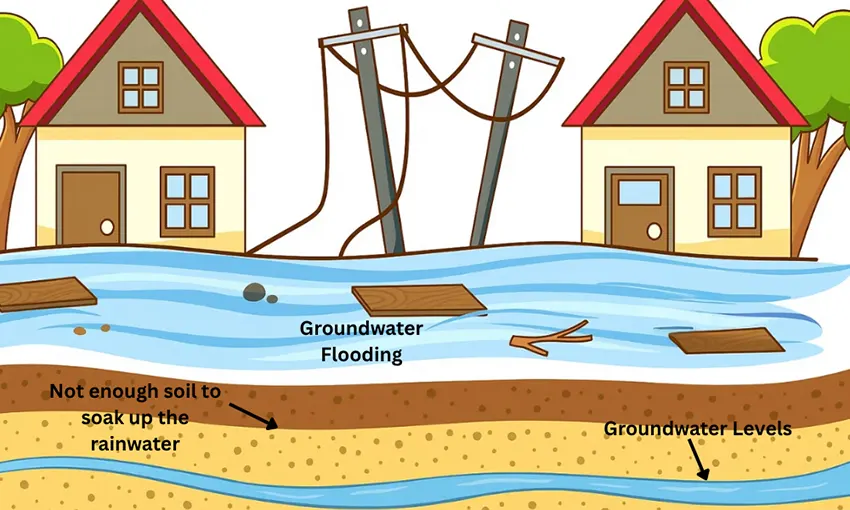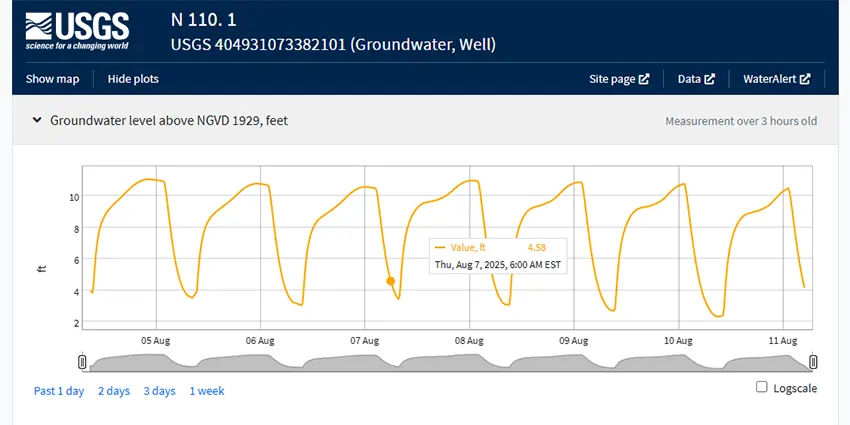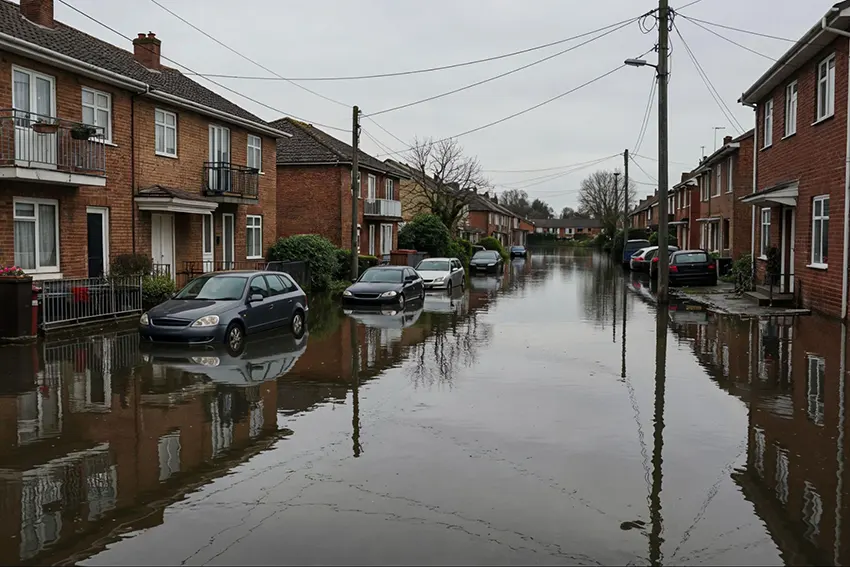Flooding causes more than $4 billion in yearly damages—something Long Island homeowners know all too well. With over 30% of Long Island Sound properties at high risk in the next big storm, the danger is anything but hypothetical.
So, what is groundwater flooding? It’s when the water table rises above the ground or seeps into basements and crawl spaces. Groundwater flooding in Long Island often strikes after heavy rain, snowmelt, or long wet spells, creeping in quietly and causing lasting structural and moisture damage. It’s one of the most overlooked threats to a home—until it becomes your reality.
In this guide, you’ll find the causes, at-risk areas, practical solutions, how insurance fits in, and steps to prevent it. Whether you’re in Port Jefferson battling high water tables and poor drainage, or in another Sound community, Zavza Seal delivers end-to-end, warranty-backed solutions to stop water ingress and safeguard your home.
Your Home Team Is Ready to Give You Back That Peace of Mind You Thought You Bought With Your Home.
Call (631) 980-1800 for a Free Expert Assessment!

What Causes Groundwater Flooding?
Most groundwater flooding starts quietly — after weeks of rain or snowmelt saturate the soil and raise the water table. The causes vary, but several factors make certain areas more prone:
- Heavy Rainfall And Prolonged Wet Weather: Continuous precipitation keeps the ground saturated, leaving no space for water to drain.
- Soil And Rock Types: Clay-heavy soils or low-permeability rock slow drainage, holding water longer and raising the risk.
- Sea-Level Rise In Coastal Communities: In low-lying coastal areas, such as parts of Long Island, higher sea levels push groundwater closer to the surface.
- Urban Groundwater Rebound: In cities, reduced pumping of groundwater for industry or utilities can allow the water table to rise again, flooding basements.
- Local Geology: Long Island’s aquifers store vast amounts of water. In wet years, these aquifers can fill quickly, leading to widespread groundwater flooding in Long Island neighborhoods.
Knowing the causes is key to prevention—see how groundwater levels affect flooding to understand how these factors interact over time.

Documented High-Groundwater Flooding Areas In Long Island, NY
In the chart above, compliments of USGS data, you can see documented high-groundwater flooding areas across Long Island. If you live or work in one of these neighborhoods, you already know the damage high groundwater can cause. Basements, crawl spaces, roads, and even schools have been hit hard over the years. The problem often starts beneath your feet: hidden high water tables pushing into homes, damaging foundations, and creating long-term issues.
Here’s where the risk is proven and ongoing:
Nassau County:
- Town Of Hempstead (Low-Lying Areas): Chronic basement flooding, record-high water tables.
- Merrick, Bellmore, Wantagh, Seaford, Massapequa: Built on former wetlands, water table near the surface.
- Levittown: Shallow groundwater; many homes slab-on-grade to avoid flooding.
- East Meadow: Poor drainage, seasonal water table spikes.
Suffolk County:
- Northeast Branch Of The Nissequogue River Basin (Smithtown/Hauppauge): Hundreds of homes, roads, and a school impacted.
- Lake Ronkonkoma Area (Smithtown/Brookhaven): Aquifer rebound floods homes, roads, and wetlands cyclically.
- Amityville, Copiague, Lindenhurst (Babylon South Shore): Persistent basement flooding tied to high tides and shallow aquifers.
These aren’t just flood zones—they’re warning signs. If your home or business is here, groundwater flooding protection should have been part of it from the start. Zavza Seal can deliver it now.
Your Home Team Is Ready to Give You Back That Peace of Mind You Thought You Bought With Your Home.
Call (631) 980-1800 Today For Your Free Inspection!
Groundwater Flooding In Basement
If your basement floor feels damp or you spot water seeping through cracks, groundwater flooding may already be underway. This type of flooding happens when the basement water table rises close enough to push water through vulnerable points in your foundation — often without heavy rainfall.
Common Entry Points:
- Hairline Cracks In Floors Or Walls
- Unsealed Joints Where Walls Meet The Slab
- Gaps Around Utility Penetrations And Pipes
- Porous Concrete Or Masonry That Absorbs Moisture
Risks To Your Home:
- Structural Damage: Prolonged Saturation Can Weaken Foundation Walls And Slabs
- Mold Growth: Damp Conditions Fuel Mold And Mildew, Impacting Health And Air Quality
- Damaged Insulation: Wet Insulation Loses Effectiveness, Driving Up Heating And Cooling Costs
- Loss Of Property Value: Persistent Water Issues Can Derail A Home Sale Or Reduce Appraisal Value
Groundwater flooding in basements is not a problem that fixes itself. Protect your investment now!
Call (631) 980-1800 Today For Your Free Inspection
Groundwater Flooding Solutions
Permanent solutions for groundwater flooding do more than keep your basement dry they protect your entire home. By addressing both the source of the water and the vulnerabilities in your foundation, you can prevent recurring damage, safeguard property value, and improve indoor health conditions.
Permanent Systems:
- Perimeter Drains: Perimeter drains are installed along the interior or exterior foundation to redirect water before it enters
- Sump Pumps: Sump pumps automatically remove collected water and discharge it safely away from the structure
- Grading Improvements: Grading improvements adjust soil slope around the home to encourage proper runoff and reduce hydrostatic pressure
Comparing Costs And Effectiveness:
While exterior perimeter drains and grading improvements often have higher upfront costs, they provide the most comprehensive groundwater flooding protection. Interior perimeter drains and sump pumps can be more cost-effective for existing homes, especially when paired together. The best solution is often a combination of methods tailored to your property’s soil, water table level, and structure type.
When To Call A Pro:
If you experience repeated water intrusion, visible signs of foundation stress, or live in a known high-water-table area, professional installation is the safest route. Pros have the tools, expertise, and materials to ensure systems are installed correctly the first time saving you from costly rework.
Next Step:
Don’t wait until the next storm or seasonal spike to take action. Schedule your Free Inspection now and discover the groundwater flooding fixes that will keep your basement and your investment protected for decades.
Real projects show how the right strategy can turn a flood-prone basement into a safe, dry space. Below are two examples that demonstrate our approach to solving groundwater flooding problems in Long Island homes from diagnosis to permanent protection.
Groundwater Flooding Case Study: Comprehensive Solution For Water Damage In Basement – Freeport, NY
A homeowner in Freeport, NY, contacted Zavza Seal LLC after repeated basement groundwater flooding during heavy rains. Water was entering through the block foundation wall near the Bilco door opening, causing visible water damage, raising concerns over potential mold growth, and reducing the usability of the basement. Previous DIY attempts had failed to stop the basement water table flooding.
Diagnosis:
Our inspection revealed cracks in both the foundation wall and concrete floor, coupled with inadequate exterior drainage and basement waterproofing. These deficiencies allowed water intrusion after every heavy rain, particularly from the Bilco door area.
Proposed Solution:
- Excavation & Waterproofing: Excavated 35 feet along the foundation wall (plus an additional 5 feet near the Bilco door) and applied a high-performance liquid waterproof membrane.
- Crack Repairs: Sealed all foundation wall cracks above and below grade.
- Protection Mat & Backfill: Installed a heavy-duty protection mat and restored grading for proper drainage.
- Masonry Coating: Applied to above-grade sections for aesthetics and additional moisture resistance.
- Sump Pump Installation: Installed a high-capacity sump pump tied to the existing discharge line to remove water quickly during storms.
Results:
During the next heavy rain, the basement remained completely dry. The combination of excavation, waterproof membrane, crack repair, and sump pump installation in Freeport, NY eliminated water intrusion, restored the space for use, and safeguarded against mold and structural damage.
Does Flood Insurance Cover Groundwater?
Many homeowners are surprised to learn that standard flood insurance often excludes groundwater flooding. The National Flood Insurance Program (NFIP) and most private carriers define a flood as surface water inundation, meaning damage from a rising water table often isn’t covered.
Coverage Limitations To Know:
- NFIP policies generally exclude damage caused by groundwater entering through floors, walls, or foundations.
- Private policies may have similar exclusions unless specific endorsements are added.
- Losses from sump pump failures or backups often require an additional rider.
If you live in a high-water-table area, review your policy now. Adding groundwater flooding insurance or sump pump failure coverage could save you from thousands in out-of-pocket repairs.
Groundwater Flooding Insurance — Top Choices
Choosing the right insurance for groundwater flooding can be the difference between full recovery and a costly setback.
What To Compare:
- Coverage Scope: Does the policy include water table intrusion or only surface flooding?
- Deductibles & Limits: Check how much you’ll pay before coverage starts and the maximum payout.
- Exclusions: Understand what’s not covered, such as seepage through cracks over time.
Pros & Cons:
- NFIP Policies: Affordable for basic flood coverage but limited for groundwater-related claims.
- Private Carriers: More flexible coverage options but often at a higher premium.
For a breakdown of terms and options, see Does Flood Insurance Cover Groundwater? before choosing a plan.
Who Is Responsible For Groundwater Flooding?
Responsibility for groundwater flooding isn’t always straightforward — and in Long Island, it can be influenced by a mix of local ordinances, state laws, property changes, and even actions taken by nearby neighbors.
Legal Factors In Long Island:
- Common-Enemy Rule (Limited Application): In certain New York cases, property owners may be allowed to redirect water off their land — but this rule has limits, and liability may still apply if the redirection is deemed unreasonable or causes significant damage.
- Civil Law Rule: New York courts often follow a modified version of this, holding property owners responsible if they alter their property in a way that unnaturally increases water flow to a neighbor’s land.
- Municipal Liability: Rare, but possible if public infrastructure, storm drains, or municipal water management directly contributes to flooding on private property.
Before taking legal or insurance action, it’s smart to get a professional inspection to confirm the cause, document the scope of the flooding, and assess any contributing factors.
For Homeowners Outside New York:
Water and property laws vary widely by state. If you’re not in Long Island, check your state’s drainage laws and consult a local attorney who specializes in groundwater flooding liability in your jurisdiction.
Ultimate Guide to Groundwater Flooding: Final Thoughts
Groundwater flooding doesn’t have to be a recurring nightmare — the right solutions can protect your home for decades. By understanding the causes, knowing your insurance options, and investing in proven mitigation systems, you can safeguard your property’s value and your family’s comfort.
Our team at Zavza Seal specializes in groundwater flooding solutions for Long Island homes, with expertise in prevention, repair, and long-term protection.
Take Action Now: Call (631) 980-1800 Today For Your Free Inspection!








